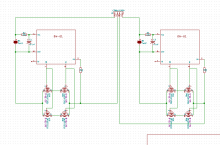How do we power the camera (and all the accessories)?
- Proposal 2**:
Inventing a new system around 18650 Cells. The pack goes on the backside of the Axiom Beta enclosure.
It should exist of different stacks:
A: battery cells with less electronics
B: electricity connectors (different versions)
C: quick release system
B and C typ stacks can be aligned in any order. The stacks itself are screwed together.






















